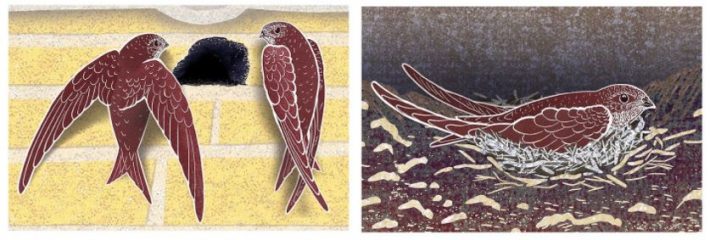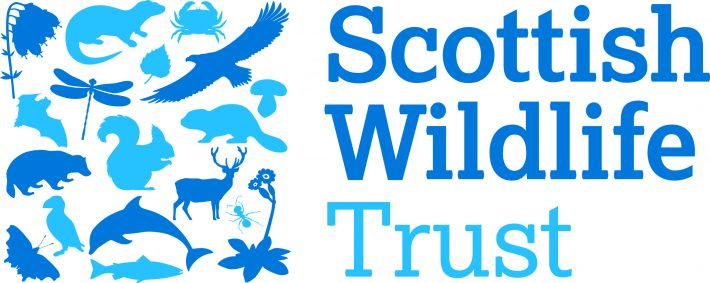Leith Walk on the wild side
This vision of a green future, created by Sarah Hannis and Donya Davidson looked at how we can promote urban biodiversity in our cities. Find out the importance of making space for nature in our cities is communicated in the artwork by reading our interview with Sarah and Donya below:

Sarah Hannis
Website | Facebook |Instagram | Twitter
Job: Illustrator and Geologist
Location: Aberlady, Scotland
Style: I love all types of printmaking but typically sketch in ink and watercolour, taking inspiration from the world around me.
Q: Tell us about your vision of a green future – what was the inspiration behind it and how did you develop the idea?
A: Leith Walk is currently the least green part of Edinburgh so we re-imagined it totally green! There’s no traffic any more, only bike lanes and a greened tramway, with habitat towers down the middle, and wildflower areas on either side. Our challenge for this piece was trying to connect the different patches of habitat and transform Leith Walk into a wildlife corridor. It may sound simple but even the addition of window boxes can help achieve this – they are like refuelling stations, providing food and shelter for bees, butterflies, moths and other insects which in turn helps the voles, birds and bats that feed on them.
Q: What hidden details should we look out for in the final piece?
A: If you look closely, the buildings are lined with swift nesting boxes and, of course, each window has its own planter of pollinator-friendly plants. I’m also a curlew ambassador for Curlew Action so I added a few tiny far away curlews flying over the rooftops in too! Can you spot them?
Q: Top tips for encouraging urban wildlife?
A: Almost everyone has access to a window, so make a small planter for your windowsill (firmly attached!) and fill it with peat-free soil and pollinator friendly plants! If you have a garden, avoid mowing and let it go wild! If you live on the top floor put up a swift nest box or an integrated ‘swift brick’.
Current Work:
- I’m currently doing the “100 days project” over on my instagram where I’m illustrating the lifecycles of Scottish creatures starting with ‘C’, one drawing a day for 100 days. So far I’ve drawn Curlew and Carrion Beetles!
- My most recent lino print is called ‘Curlews’ and is based on my sketches and photos of Curlews from the estuary near where I live. They’re away breeding inland at the moment and I miss them, especially their haunting call! Fingers crossed their breeding success improves and that they will be around for generations to come. My etsy shop has original lino prints, cards and notebooks for sale with 50% going to Curlew Action: https://www.etsy.com/shop/SarahHannisDesigns

Donya Davidson
LinkedIn | Twitter | Instagram
Job: Ecologist and Project Development Officer
Organisation: the Scottish Wildlife Trust
Location: Edinburgh
Bio: I’m currently working on Edinburgh’s Thriving Green Spaces project with the Scottish Wildlife Trust but have been lucky to work across a variety of habitats from urban environments to remote and rural areas in the Scottish Highlands whilst in the environmental sector.
Q: For the virtual exhibition, your vision of a green future transformed Edinburgh’s Leith Walk into a wildlife haven. Do you have any real-world examples where this is already happening?
A: At the Scottish Wildlife Trust, I lead on the Ecology workstream as part of the Edinburgh’s Thriving Green Spaces project. This is a really exciting project that aims to create a new vision for the city’s green spaces, rivers, lochs and shoreline through an ambitious 30-year strategy. As part of this, we have been gathering information on how to create stepping stone habitats for species to travel around the city, including pollinators and rare species like the Northern Brown Argus butterfly, as well as other urban species such as bats, foxes and badgers. In our artwork we therefore turned the whole street from grey to green with wildflower meadows and window planters for flying insects and pollinators plus vertical nesting and roosting towers for bats, swifts and other nesting bird species.
Q: That sounds idyllic! Can you talk us through the ecology behind these ideas?
A: Habitat fragmentation is a common issue in our cities, but through the addition of windowsill planters and wildflower meadows, we can start to connect up habitat for pollinators and rare insect species such as the northern brown argus, so that they can move freely through the city and colonise new areas. The range of green infrastructure you can see in the artwork can also provide extra habitat patches while the pond helps cool outdoor temperatures and tackle the urban heat island effect. Although it is an aspirational vision, I hope it is something we can see the likes of in the not so distant future, for a connected, biodiverse and sustainable Edinburgh.
Current Work:
- For information on the wider Thriving Green Spaces project and to hear about any upcoming events, please visit our project website.

Future Green Spaces Virtual Exhibition
You can check out the final masterpiece and all the other brilliant artworks via our virtual gallery overlooking Edinburgh’s iconic Arthur’s Seat, You can the exhibition and all other BES online events (from an ecology-themed comedy night and draw-alongs to insect decline debates) on the BES Edinburgh Science Festival event hub here.
Like what we stand for?
Support our mission and help develop the next generation of ecologists by donating to the British Ecological Society.